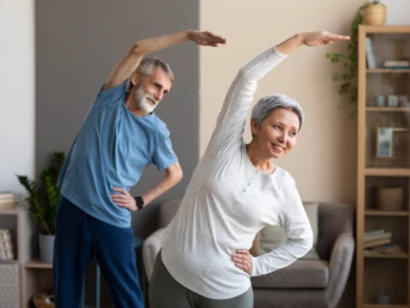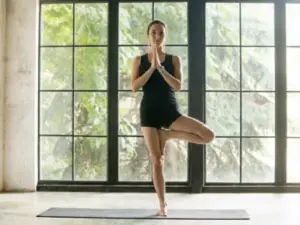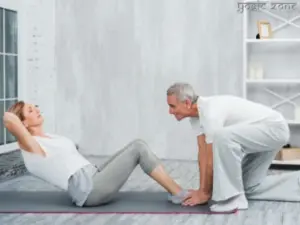
Certified Yoga Instructor | Aerial Yoga Practitioner | Counselling Psychologist | M.Sc. in Psychology (Clinical) | National-Level Skater. Know more about Devi Diya G S
As a longtime practitioner and teacher of yoga, one of the most heartwarming trends I have witnessed is the increasing number of seniors discovering the health benefits of this ancient discipline. Yoga for seniors is a dedicated, gentle practice focused on stability and strength and can be one of the most impactful lifestyle changes for anyone over the age of sixty.
Why Yoga for Seniors Matters
Yoga for seniors strengthens muscles without strain, improves circulation, and supports better posture, all of which contribute to fall prevention and better posture. Gentle asanas for elders offer a safe and effective way to support healthy aging.
Maintaining physical strength and balance becomes more essential as we age. When physical strength and balance decline, everyday activities like using the stairs, getting up from a chair, or reaching for an item on a high shelf become difficult, and the risk of falls increases, leading to loss of independence.

Recommended Asanas for Strength and Stability
Here are a few asanas I often include in senior-friendly trainings. Each one supports strength, balance, and confidence in a gentle, accessible way.
Note: Discuss your medical history and daily activities with your yoga trainer before starting.
Do you have any doubts or questions about this article?? I am Devi Diya, the author, and I would love to hear from you. Send us your question now!
Yoga for Seniors That Build Strength
1. Virasana (Hero Asana)
Excellent for strengthening the arches of the feet and knees while stretching the hips and thighs. A supportive bolster can be used to make this asana very accessible. Using yoga props is highly recommended for seniors; read our blog on yoga props for beginners to know about the benefits of props.
2. Setu Bandhasana (Bridge Asana)
A gentle yet powerful back-bending asana that strengthens the back, buttocks, and hamstrings (a group of muscles that run along the back of the thigh, extending from the hip bone to just below the knee joint) while opening the chest. This is a wonderful asana for counteracting the effects of prolonged sitting.
3. Dandasana (Staff Asana)
While seemingly simple, this asana is foundational for good posture. It engages the mid-body and back muscles, teaching the body to sit erect and straight, which is key for a strong spine.
Yoga for Seniors for the Power of Balance
Perhaps the most critical benefit of regular yoga for seniors is the dramatic improvement in balance. Balance is a complex skill, relying on coordination between the inner ear, eyes, muscles, and brain.
Asanas That Enhance Stability and Balance:
1. Tadasana (Mountain Asana)
This foundational standing asana helps cultivate awareness of posture and alignment. Practicing Tadasana regularly can improve spinal stability and activate the legs, making it easier to stand tall and walk with confidence.
2. Vrksasana (Tree Asana)
Vrksasana is a beautiful way to build balance and focus. Initially practice it with support; using a wall or a chair, this asana can strengthen the ankles, calves, and back muscles. It also encourages mental calm, which is just as important as physical equilibrium.
3. Utkatasana (Chair Asana)
Not to be confused with actual chair yoga, Utkatasana copies the action of sitting and rising. It’s great for building leg strength and improving coordination. Practicing this asana can make everyday movements like getting up from a chair feel easier and safer.
Note: The asanas mentioned here are recommended by our qualified and experienced authors for general awareness and inspiration. We do not provide step-by-step instructions, as each individual’s physical condition and needs are unique. We strongly recommend learning yoga under the guidance of a qualified instructor who can offer personalised support and ensure safe practice.
Making Yoga for Seniors Accessible and Enjoyable
One of the most important aspects of yoga for seniors is accessibility. That means using props like chairs, blocks, or walls without hesitation. Read our blog on yoga block uses.
It also means choosing asanas that feel nourishing, not punishing.
I often remind my students that yoga is not about achieving a perfect shape—it’s about feeling more at home in your body.
Breathwork (pranayama) and mindfulness can also be included in your practice to reduce anxiety and improve sleep. Even five minutes of deep breathing or seated meditation can make a noticeable difference in mood and energy levels.
The journey of yoga for seniors is a journey of self-care, an investment in your future self.
Yoga for seniors is more than a physical routine; it’s a gentle companion on the journey of aging. These simple asanas offer a way to reconnect with your body, build strength, and find balance—both physically and emotionally.
If you’re just starting out, begin slowly. Choose one or two asanas that you are comfortable with, and practice them regularly. Over time, you will notice subtle changes: steadier steps, deeper breaths, and a growing sense of confidence.
Do you have any doubts or questions about this article?? I am Devi Diya, the author, and I would love to hear from you. Send us your question now!
Frequently Asked Questions About Yoga for Seniors
Is yoga safe for seniors, especially if I haven’t exercised in years?
Yes, yoga is generally safe for seniors, even if you are starting after a long break. The key is to begin gently and choose beginner-friendly or chair-supported yoga classes. Always move at your own pace and avoid pushing into pain. If you have chronic conditions, consulting your doctor or a trained yoga instructor is recommended.
What types of yoga are suitable for seniors?
Gentle styles like Hatha yoga, Iyengar yoga, and Restorative yoga are ideal for seniors. These forms provide slow-paced, aligned movements and often incorporate props like blankets, straps, and blocks that support proper posture and reduce injury risk while building strength and flexibility.
What are the best beginner-friendly yoga poses for older adults with limited flexibility?
Some safe and accessible asanas include:
Tadasana (Mountain Asana)
Vrksasana (Tree Asana)
Setu Bandhasana (Bridge Asana)
Dandasana (Staff Asana)
These asanas help improve flexibility, posture, and joint mobility without straining the body.Can yoga help with joint pain, arthritis, or stiffness in seniors?
Yes. Slow, controlled stretching in yoga helps lubricate joints, reduce inflammation, and improve the range of motion. Gentle yoga styles like Hatha yoga, Restorative yoga, and Chair Yoga are known to ease arthritis symptoms and reduce stiffness, especially when practiced regularly.
How can yoga help improve balance and prevent falls in seniors?
Yoga strengthens muscle tone, improves joint stability, and enhances body awareness—all crucial for maintaining balance. Regular practice can reduce the risk of falls, a common concern among older adults, by improving coordination and reaction time.
What precautions should seniors take before starting yoga?
Seniors should consult with a healthcare professional before beginning yoga, especially if they have chronic health issues. Starting with a certified yoga instructor who understands seniors’ needs and focusing on gentle, modified poses can prevent injury and maximize benefits.
Are there any medical conditions where seniors should avoid certain yoga poses?
Seniors with conditions such as severe osteoporosis, uncontrolled blood pressure, vertigo, herniated discs, or recent surgeries should avoid deep twists, high-impact transitions, or full inversions. A doctor or yoga therapist can help identify modifications to keep the practice safe.
How often should seniors practice yoga to see benefits like better balance and mobility?
Consistency is key. Practicing yoga 3 to 5 times per week is recommended to see improvements in flexibility, strength, and mental well-being. Sessions can be short and gentle, tailored to individual stamina and health conditions.



